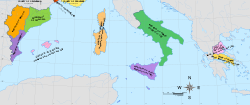
Back Reino d'Aragón AN مملكة أرغون Arabic مملكة اراجون ARZ Reinu d'Aragón AST Araqon krallığı Azerbaijani آراقون شاهلیغی AZB Арагон короллеге Bashkir Каралеўства Арагон Byelorussian Арагон (каралеўства) BE-X-OLD Кралство Арагон Bulgarian
This article needs additional citations for verification. (May 2009) |
Kingdom of Aragon | |||||||||||
|---|---|---|---|---|---|---|---|---|---|---|---|
| 1035–1707 | |||||||||||
 | |||||||||||
 Location of the Kingdom of Aragon (orange, at the left) within the Crown of Aragon | |||||||||||
| Status | Independent kingdom (1035–1162) Kingdom of the Crown of Aragon (1162–1707) | ||||||||||
| Capital | |||||||||||
| Common languages | Aragonese, Castilian, Catalan, Latin, Mozarabic, Andalusi Arabic | ||||||||||
| Religion | Roman Catholicism[1] Judaism (minority, until 1492) Islam (minority, until 1526) | ||||||||||
| Government | Feudal monarchy | ||||||||||
| Legislature | Cortes of Aragon | ||||||||||
| Historical era | Medieval<br ]] | ||||||||||
• County of Aragon established as independent kingdom | 1035 | ||||||||||
• Nueva Planta decrees dissolved Aragonese institutions | 1707 | ||||||||||
| |||||||||||
| Today part of | Spain | ||||||||||
The Kingdom of Aragon (Aragonese: Reino d'Aragón; Catalan: Regne d'Aragó; Latin: Regnum Aragoniae; Spanish: Reino de Aragón) was a medieval and early modern kingdom on the Iberian Peninsula, corresponding to the modern-day autonomous community of Aragon, in Spain. It was part of the larger Crown of Aragon, which also included other territories—the Principality of Catalonia (which included the former Catalan Counties), the Kingdom of Valencia, the Kingdom of Majorca, and other possessions that are now part of France, Italy, and Greece—that were also under the rule of the King of Aragon, but were administered separately from the Kingdom of Aragon.
In 1479, upon John II of Aragon's death, the crowns of Aragon and Castile were united to form the nucleus of modern Spain. The Aragonese lands retained autonomous parliamentary and administrative institutions, such as the Corts. The arrangement remained until the Nueva Planta decrees, promulgated between 1707 and 1715 by Philip V of Spain in the aftermath of the War of the Spanish Succession, centralised power in Spain.[2][3] However, the title "King of Aragon" would continue to be used by the centralised Spanish crown.
- ^ Holt, Andrew (2016). Great Events in Religion: An Encyclopedia of Pivotal Events in Religious History [3 volumes]. ABC-CLIO. p. 763. ISBN 978-1610695664.
- ^ I. Ruiz Rodríguez, Apuntes de historia del derecho y de las instituciones españolas, Dykinson, Madrid, 2005, p. 179. (In Spanish)
- ^ Spengler, Robert N. (2020). Fruit from the Sands: The Silk Road Origins of the Foods We Eat. Univ of California Press. ISBN 978-0-520-37926-8.